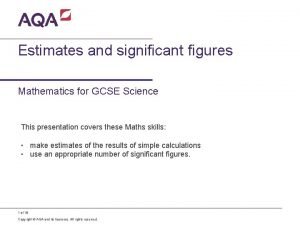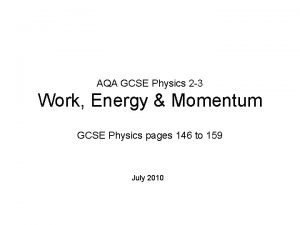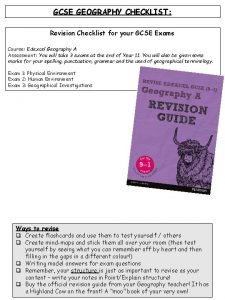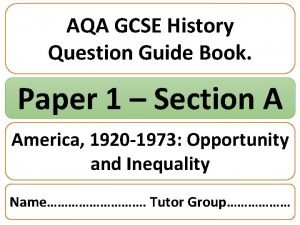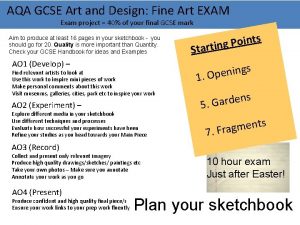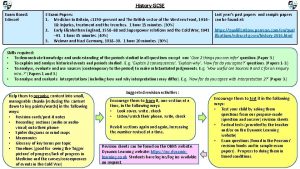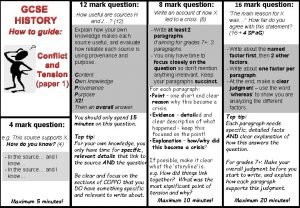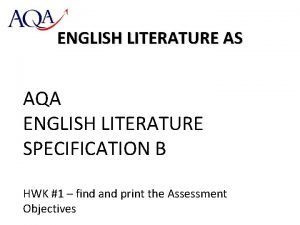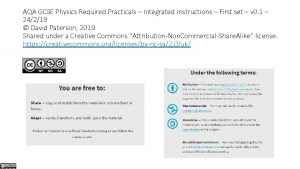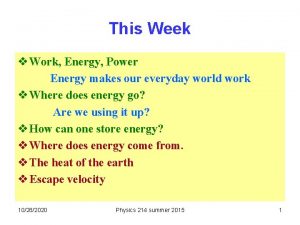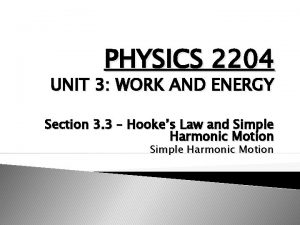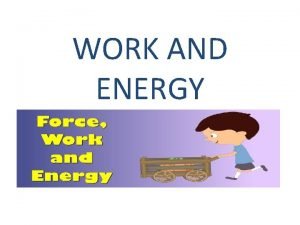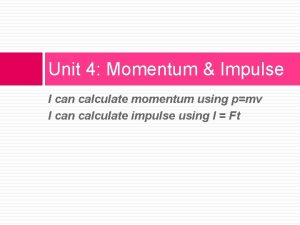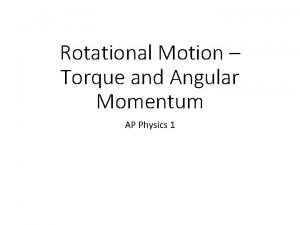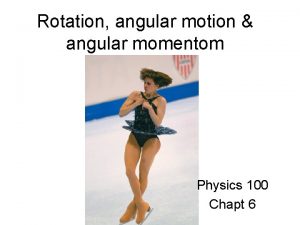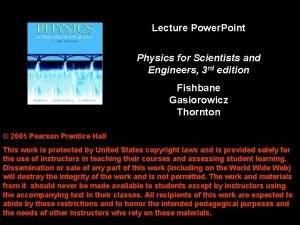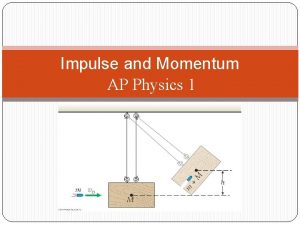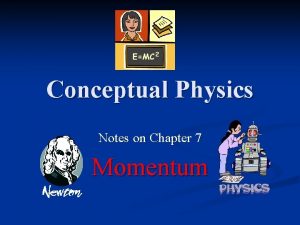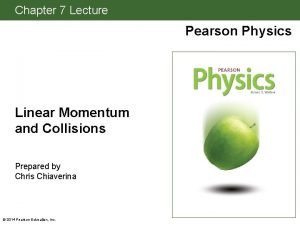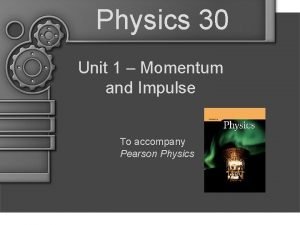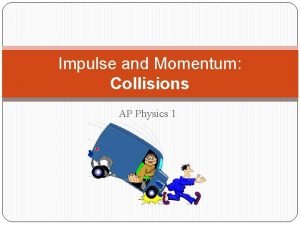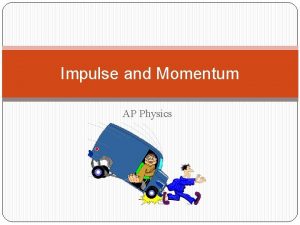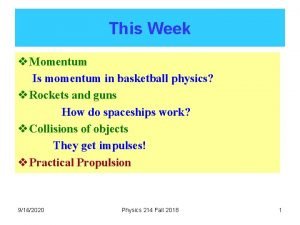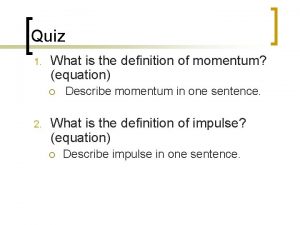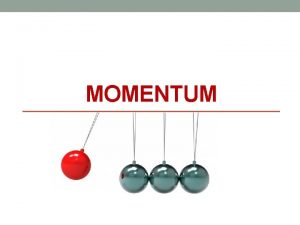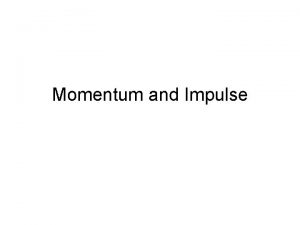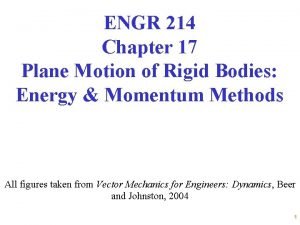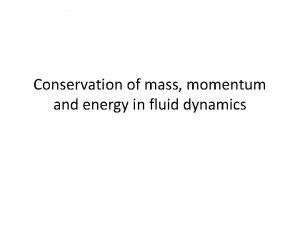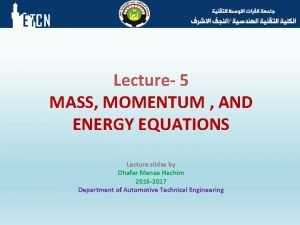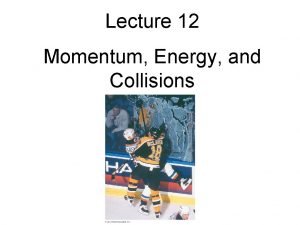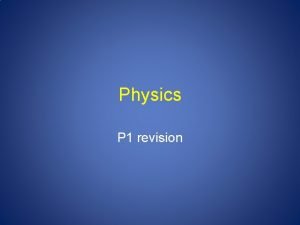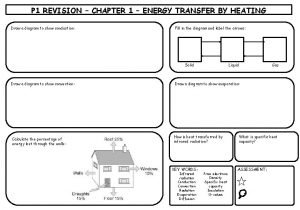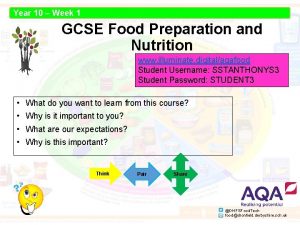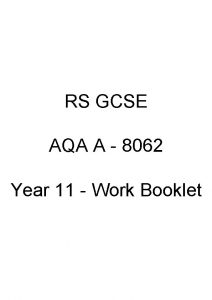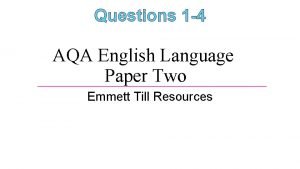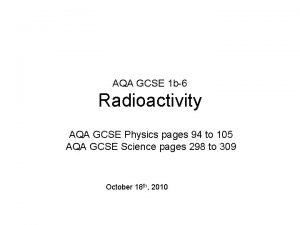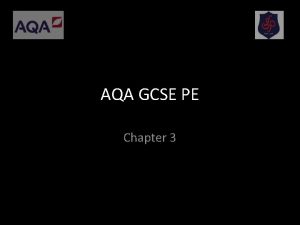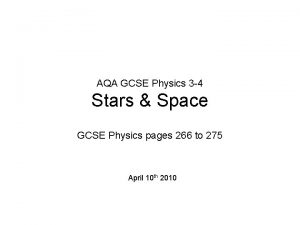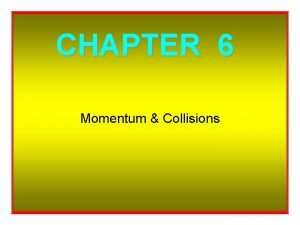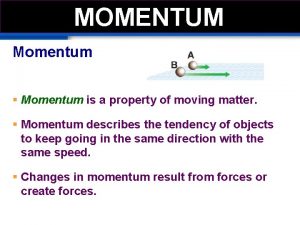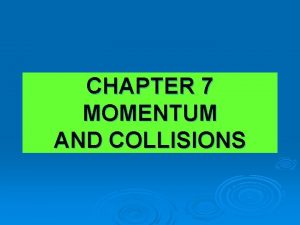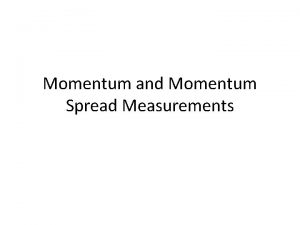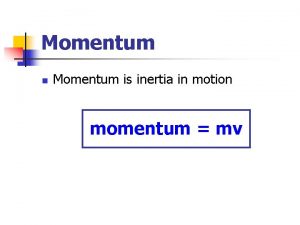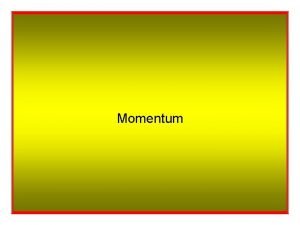AQA GCSE Physics 2 3 Work Energy Momentum







































































- Slides: 71

AQA GCSE Physics 2 -3 Work, Energy & Momentum GCSE Physics pages 146 to 159 July 2010

AQA GCSE Specification WORK & ENERGY 12. 3 What happens to the movement energy when things speed up or slow down? Using skills, knowledge and understanding of how science works: • to discuss the transformation of kinetic energy to other forms of energy in particular situations. Skills, knowledge and understanding of how science works set in the context of: • When a force causes a body to move through a distance, energy is transferred and work is done. • Work done = energy transferred. • The amount of work done, force and distance are related by the equation: work done = force applied × distance moved in direction of force • Work done against frictional forces is mainly transformed into heat. • Elastic potential is the energy stored in an object when work is done on the object to change its shape. • The kinetic energy of a body depends on its mass and its speed. HT Calculate the kinetic energy of a body using the equation: kinetic energy = ½ × mass × speed 2 MOMENTUM 12. 4 What is momentum? Using skills, knowledge and understanding of how science works: • to use the conservation of momentum (in one dimension) to calculate the mass, velocity or momentum of a body involved in a collision or explosion • to use the ideas of momentum to explain safety features. Skills, knowledge and understanding of how science works set in the context of: • Momentum, mass and velocity are related by the equation: momentum = mass × velocity • Momentum has both magnitude and direction. • When a force acts on a body that is moving, or able to move, a change in momentum occurs. • Momentum is conserved in any collision/explosion provided no external forces act on the colliding/exploding bodies. HT Force, change in momentum and time taken for the change are related by the equation: force = change in momentum / time taken for the change

Work When a force causes a body to move through a distance, energy is transferred and work is done. Work done = energy transferred. Both work and energy are measured in joules (J).

Work and friction Work done against frictional forces is mainly transformed into heat. Rubbing hands together causes them to become warm. Brakes pads become hot if they are applied for too long. In this case some of the car’s energy may also be transferred to sound in the form of a ‘squeal’

The work equation The amount of work done, force and distance are related by the equation: work done = force applied × distance moved in the direction of the force Work is measured in joules (J) Force is measured in newtons (N) Distance is measured in metres (m)

also: force = work done ÷ distance moved and: distance = work done ÷ force work force distance

Question 1 Calculate the work done when a force of 5 newtons moves through a distance of 3 metres. work = force x distance = 5 N x 3 m work = 15 joules

Question 2 Calculate the work done when a force of 6 newtons moves through a distance of 40 centimetres. work = force x distance = 6 N x 40 cm = 6 N x 0. 40 m work = 2. 4 joules

Question 3 Calculate the value of the force required to do 600 joules of work over a distance of 50 metres. work = force x distance becomes: force = work done ÷ distance = 600 J ÷ 50 m force = 12 newtons

Question 4 Calculate the distance moved by a force of 8 newtons when it does 72 joules of work = force x distance becomes: distance = work done ÷ force = 72 J ÷ 8 N distance moved = 9 metres

Question 5 Calculate the work done by a child of weight 300 N who climbs up a set of stairs consisting of 12 steps each of height 20 cm. work = force x distance The child must exert an upward force equal to its own weight. Therefore: force = 300 N This force is exerted upwards and so the distance must also be measured upwards. = (12 x 20 cm) = 2. 4 m therefore: work = 300 N x 2. 4 m work = 720 J

Question 6 Calculate the work done by a person of mass 80 kg who climbs up a set of stairs consisting of 25 steps each of height 10 cm. work = force x distance the person must exert an upward force equal their weight the person’s weight = (80 kg x 10 N/kg) = 800 N the distance moved upwards equals (10 x 25 cm) = 2. 5 m work = 800 N x 2. 5 m work = 2000 J

Complete Answers work force distance 150 J 50 N 3 m 800 J 40 N 20 m 500 J 250 N 2 m 80 k. J 4000 N 2 m 2 MJ 3. 03 400 N 5 km

Choose appropriate words to fill in the gaps below: force Work is done when a _______ moves through a distance. energy transferred is also equal to the work The amount of _______ heat done. When a car brakes energy is transformed to ______. equal to the force _____ multiplied by the distance Work done is ______ moved in the _____ of the force. The work done is direction measured in ______ joules if the force is measured in newtons and distance in metres. the _____ WORD SELECTION: energy direction force equal multiplied distance heat joules

Energy and work Notes questions from pages 146 & 147 1. What is meant by ‘work’? 2. Copy both of the equations for work on page 146 along with the units used. 3. Copy and answer questions (a) and (b) on pages 146 and 147. 4. Explain two ways in which the force of friction causes energy to be transformed into heat. 5. Copy the Key Points on page 147. 6. Answer the summary questions on page 147.

Energy and work ANSWERS In text questions: (a) To the surroundings as heat energy and sound energy (b) 300 J Summary questions: 1. (a) 96 J (b) 96 J 2. (a) (i) 90 J (ii) 4500 J (b) 0. 60 m

Potential energy Elastic potential energy is the energy stored in an object when work is done on an object to change its shape. An elastic object regains its shape after being stretched or squashed. Elastic potential energy is stored in the bow string when it is pulled by the archer.

Gravitational potential energy is the energy stored in an object when work is done in moving the object upwards. The potential energy stored is equal to the weight of the object multiplied by the height lifted. The weightlifter stores gravitational potential energy when he lifts the weights.

Kinetic energy is the energy possessed by a body because of its speed and mass. kinetic energy = ½ x mass x (speed)2 kinetic energy is measured in joules (J) mass is measured in kilograms (kg) speed is measured in metres per second (m/s)

Question 1 Calculate the kinetic energy of a car of mass 1000 kg moving at 5 m/s. kinetic energy = ½ x mass x (speed)2 kinetic energy = ½ x 1000 kg x (5 m/s)2 kinetic energy = ½ x 1000 x 25 kinetic energy = 500 x 25 kinetic energy = 12 500 joules

Question 2 Calculate the kinetic energy of a child of mass 60 kg moving at 3 m/s. kinetic energy = k. e. = ½ x 60 kg k. e. = ½ x 60 x k. e. = 30 x 9 kinetic energy = ½ x mass x (speed)2 x (3 m/s)2 9 270 J

Question 3 Calculate the kinetic energy of a apple of mass 200 g moving at 12 m/s. kinetic energy = ½ x mass x (speed)2 k. e. = ½ x 200 g x (12 m/s)2 k. e. = ½ x 0. 200 kg x 144 k. e. = 0. 100 x 144 kinetic energy = 14. 4 J

Question 4 Calculate the mass of a train if its kinetic energy is 2 MJ when it is travelling at 4 m/s. kinetic energy = ½ x mass x (speed)2 2 MJ = ½ x mass x (4 m/s)2 2 000 J = ½ x mass x 16 2 000 = 8 x mass 2 000 ÷ 8 = mass = 250 000 kg

Question 5 Calculate the speed of a car of mass 1200 kg if its kinetic energy is 15 000 J. kinetic energy = ½ x mass x (speed)2 15 000 J = ½ x 1200 kg x (speed)2 15 000 = 600 x (speed)2 15 000 ÷ 600 = (speed)2 25 = (speed)2 speed = 25 speed = 5 m/s

Question 6 Calculate the speed of a ball of mass 400 g if its kinetic energy is 20 J. kinetic energy = ½ x mass x (speed)2 20 J = ½ x 400 g x (speed)2 20 = ½ x 0. 400 kg x (speed)2 20 = 0. 200 x (speed)2 20 ÷ 0. 200 = (speed)2 100 = (speed)2 speed = 100 speed = 10 m/s

Complete Answers kinetic energy mass speed 8 J 4 kg 2 m/s 27 J 6 kg 3 m/s 1000 J 80 kg 5 m/s 6. 4 k. J 200 kg 8 m/s 3. 2 J 3. 03 g 400 4 m/s

Choose appropriate words to fill in the gaps below: potential energy is the energy stored when an object Elastic ____ squashed This energy is released when the is stretched or ____. returns to its original shape. object ____ Kinetic energy is the energy possessed by an object due to its speed and mass. If the mass of an object is ____ doubled its _______ kinetic energy doubles. If the speed is doubled the kinetic four energy will increase by ______ times. stretched When a _____ elastic band is released elastic potential kinetic energy is converted into _____ energy. WORD SELECTION: returns speed four kinetic potential squashed doubled stretched

Kinetic energy Notes questions from pages 148 & 149 1. 2. 3. 4. 5. 6. 7. 8. How can gravitational potential energy be calculated? (see the practical on page 148) Copy the equation for kinetic energy at the top of page 149 along with the units used. Repeat the calculation below the kinetic energy equation but this time with a mass of 400 kg moving at a speed of 8 m/s. What does ‘elastic’ mean? What is elastic potential energy? Copy and answer question (b) on page 149. Copy the Key Points on page 149. Answer the summary questions on page 149.

Kinetic energy ANSWERS In text question: (b) Heat energy transferred to the surroundings, the foot and the shoe; also sound energy. Summary questions: 1. (a) (i) Chemical energy from the loader is transferred into elastic potential energy of the catapult and some is wasted as heat energy. (ii) Elastic potential energy in the catapult is transformed into kinetic energy of the object and the rubber band heat energy (plus a little sound energy). (b) (i) 10 J (ii) 10 J 2. (a) 3800 N (b) Friction due to the brakes transforms it from kinetic energy of the car to heat energy in the brakes. (c) 800 kg

Momentum momentum = mass x velocity mass is measured in kilograms (kg) velocity is measured in metres per second (m/s) momentum is measured in: kilogram metres per second (kg m/s)

Momentum has both magnitude and direction. Its direction is the same as the velocity. The greater the mass of a rugby player the greater is his momentum

Question 1 Calculate the momentum of a rugby player, mass 120 kg moving at 3 m/s. momentum = mass x velocity = 120 kg x 3 m/s momentum = 360 kg m/s

Question 2 Calculate the mass of a car that when moving at 25 m/s has a momentum of 20 000 kg m/s. momentum = mass x velocity becomes: mass = momentum ÷ velocity = 20000 kg m/s ÷ 25 m/s mass = 800 kg

Complete Answers momentum mass velocity 150 kg m/s 50 kg 3 m/s 160 kg m/s 8 kg 20 m/s 1500 kg m/s 250 kg 6 m/s 4 kg m/s 500 g 8 m/s 3 kg m/s kgkg 6 50 cm/s

Momentum conservation Momentum is conserved in any collision or explosion provided no external forces act on the colliding or exploding bodies. The initial momentum of the yellow car has been conserved and transferred to the red car

Question 1 A truck of mass 0. 5 kg moving at 1. 2 m/s collides and remains attached to another, initially stationary truck of mass 1. 5 kg. Calculate the velocity of the trucks after the collision.

total momentum before collision momentum = mass x velocity 0. 5 kg truck: = 0. 5 kg x 1. 2 m/s = 0. 6 kg m/s 1. 5 kg truck: = 1. 5 kg x 0 m/s = 0 kg m/s total initial momentum = 0. 6 kg m/s Momentum is conserved in the collision so total momentum after collision = 0. 6 kg m/s total momentum = total mass x velocity 0. 6 kg m/s = 2. 0 kg x velocity 0. 6 ÷ 2. 0 = velocity = 0. 3 m/s

Question 2 A train wagon of mass 800 kg moving at 4 m/s collides and remains attached to another wagon of mass 1200 kg that is moving in the same direction at 2 m/s. Calculate the velocity of the wagons after the collision.

total momentum before collision momentum = mass x velocity 800 kg wagon: = 800 kg x 4 m/s = 3200 kg m/s 1200 kg truck: = 1200 kg x 2 m/s = 2400 kg m/s total initial momentum = 5600 kg m/s Momentum is conserved in the collision so total momentum after collision = 5600 kg m/s total momentum = total mass x velocity 5600 kg m/s = 2000 kg x velocity 5600 ÷ 2000 = velocity = 2. 8 m/s

Choose appropriate words to fill in the gaps below: mass multiplied The momentum of an object is equal to its ______ direction by its velocity. Momentum has _____, the same as the velocity, and is measured in kilogram _______ metres per second. forces act In any interaction of bodies, where no external _______ momentum is conserved. on the bodies, _____ In snooker, a head-on collision of a white ball with a red ball same initial can result in the red ball moving off with the ______ velocity of the white ball. This is an example of momentum conservation ______. WORD SELECTION: direction forces same conservation metres momentum mass

Momentum Notes questions from pages 214 & 215 1. 2. 3. 4. 5. 6. 7. 8. What is ‘momentum’? Copy out the equation at the top of page 214. State the units for each quantity in the equation. Copy and answer question (a) on page 214. Under a heading “Conservation of momentum” copy out the statement in bold at the bottom of page 214. Copy out the worked example on page 215. Copy and answer question (b) on page 215. Copy the Key Points on page 215. Answer the summary questions on page 215.

Momentum ANSWERS In text questions: (a) 240 kg m/s (b) 0. 48 m/s Summary questions: 1. (a) mass, velocity (b) momentum, force 2. (a) 5000 kg m/s (b) velocity = momentum / mass = 5000 / 2500 = 2. 0 m/s

Head-on collisions In this case bodies are moving in opposite directions. Momentum has direction. One direction is treated as positive, the other as negative. In calculations the velocity of one of the colliding bodies must be entered as a NEGATIVE number. NEGATIVE DIRECTION OF MOTION + ve velocity - ve velocity POSITIVE

Question 1 A car of mass 1000 kg moving at 20 m/s makes a head-on collision with a lorry of mass 2000 kg moving at 16 m/s. Calculate their common velocity after the collision if they remain attached to each other. lorry, mass 2000 kg car, mass 1000 kg 20 m/s NEGATIVE 16 m/s DIRECTION OF MOTION POSITIVE

total momentum before collision momentum = mass x velocity car: = 1000 kg x +20 m/s = +20000 kg m/s lorry: = 2000 kg x -16 m/s = -32000 kg m/s total initial momentum = -12000 kg m/s Momentum is conserved in the collision so total momentum after collision = -12000 kg m/s total momentum = total mass x velocity -12000 kg m/s = 3000 kg x velocity -12000 ÷ 3000 = velocity common velocity = - 4 m/s The lorry/car combination will move in the negative direction (to the left in this case) with a common velocity of 4 m/s.

Question 2 A car of mass 1000 kg moving at 30 m/s makes a head-on collision with a lorry of mass 2000 kg moving at 15 m/s. Calculate their common velocity after the collision if they remain attached to each other. lorry, mass 2000 kg car, mass 1000 kg 30 m/s NEGATIVE 15 m/s DIRECTION OF MOTION POSITIVE

total momentum before collision momentum = mass x velocity car: = 1000 kg x +30 m/s = +30000 kg m/s lorry: = 2000 kg x -15 m/s = -30000 kg m/s total initial momentum = 0 kg m/s Momentum is conserved in the collision so total momentum after collision = 0 kg m/s The lorry/car combination will not move after the collision.

Explosions Before an explosion the total momentum is zero. As momentum is conserved, the total momentum afterwards must also be zero. This means that the different parts of the exploding body must move off in different directions.

Question 1 An artillery gun of mass 1500 kg fires a shell of mass 20 kg at a velocity of 150 m/s. Calculate the recoil velocity of the gun. artillery gun, mass 1500 kg shell, mass 20 kg recoil IO TION O M F NO DIRECT IVE NEGAT 150 m/s VE POSITI

The total momentum before and after the explosion is ZERO momentum = mass x velocity shell: = 20 kg x +150 m/s = +3000 kg m/s This must cancel the momentum of the gun. Therefore the gun’s momentum must be -3000 kg m/s gun: = 1500 kg x recoil velocity = -3000 kg m/s recoil velocity = - 3000 ÷ 1500 = - 2 m/s The gun will recoil (move to the left) with a velocity of 2 m/s.

Question 2 A girl of mass 60 kg throws a boy, mass 90 kg out off a swimming pool at a velocity of 2 m/s. What is the girl’s recoil velocity? boy, mass 90 kg girl, mass 60 kg 2 m/s recoil DIRECTION OF MOTION NEGATIVE POSITIVE

The total momentum before and after throwing the boy is ZERO momentum = mass x velocity boy: = 90 kg x +2 m/s = +180 kg m/s This must cancel the momentum of the girl. Therefore the girl’s momentum must be -180 kg m/s gun: = 60 kg x recoil velocity = -180 kg m/s recoil velocity = - 180 ÷ 60 = - 3 m/s The girl will recoil (move to the left) with a velocity of 3 m/s.

More on collisions and explosions Notes questions from pages 152 & 153 1. Apart from size what other property does momentum have? 2. Copy and answer question (a) on page 152. 3. Explain how conservation of momentum applies in an explosion. 4. Why do guns recoil? 5. Copy and answer question (b) on page 153. 6. Copy the Key Points on page 153. 7. Answer the summary questions on page 153.

More on collisions and explosions ANSWERS In text questions: (a) The boat and the person who jumps off move away with equal and opposite amounts of momentum. (b) 25 m/s Summary questions: 1. (a) momentum (b) velocity (c) force 2. (a) 60 kg m/s (b) 1. 5 m/s

Force and momentum A force will cause the velocity of an object to change and therefore also its momentum. The greater the force the faster the momentum changes.

force = change in momentum time taken for the change force is measured in newtons (N) change in momentum is measured in: kilogram metres per second (kg m/s) time is measured in seconds (s)

Equation proof acceleration = velocity change ÷ time taken multiplying both sides of this equation by ‘mass’ gives: (mass x acceleration) = (mass x velocity) change ÷ time but: (mass x acceleration) = force and: (mass x velocity) = momentum therefore: force = momentum change ÷ time taken

Question 1 Calculate the force required to change the momentum of a car by 24000 kgm/s over a 6 second period. force = momentum change ÷ time taken = 24000 kgm/s ÷ 6 s force = 4000 N

Question 2 Calculate the time taken for a force of 6000 N to cause the momentum of truck to change by 42000 kgm/s. force = momentum change ÷ time taken becomes: time taken = momentum change ÷ force = 42000 kgm/s ÷ 6000 N force = 7 seconds

Complete Answers force time taken 200 N momentum change 8000 kgm/s 25 N 500 kgm/s 20 s 500 N 3000 kgm/s 6 s 800 N 8000 kgm/s 10 s 4 N 480 kgm/s 2 minutes 40 s

Car safety features

Crumple zones, air bags and a collapsible steering wheel are designed to increase the time taken for a driver or passenger to change momentum to zero during a crash. The equation: force = momentum change ÷ time taken shows that if the time taken is increased for the same momentum change the force exerted is decreased so is the injury to the driver or passenger.

Playground flooring question ANSWER: The picture shows rubber tiles used for playground When a child falls to the floor its flooring. Explain how these can reduce injury to children. momentum changes from a high value to zero. The rubber flooring tiles increase the time taken for this change. force = change in momentum ÷ time taken for the change Therefore the force on the child is reduced and so is the potential injury.

Choose appropriate words to fill in the gaps below: momentum The force exerted on an object is equal to the _____ time change caused divided by the ______ taken for the change. crash An airbag activates during a car _______. The inflated increases the time taken for a driver’s or airbag _____ velocity to fall to zero. The time taken for their passenger’s ____ momentum to fall to ______zero is also increased. Therefore the _______ exertedforce on the driver or passenger is _____ decreased injury and so is the potential ____ caused. WORD SELECTION: time velocity zero momentum force decreased injury increases crash

Changing momentum Notes questions from pages 154 & 155 1. What is the purpose of a car’s crumple zones? 2. Copy the key points on page 155. 3. Copy and answer questions (a), (b) and (c) on pages 154 and 155. 4. Copy the Key Points on page 155. 5. Answer the summary questions on page 155.

Changing momentum ANSWERS In text questions: (a) If a child falls off a swing, the rubber mat reduces the impact force by increasing the impact time when the child hits the ground. (b) The force is bigger (c) 1800 N Summary questions: 1. (a) stays the same (b) increases (c) decreases 2. (a) 24 000 kg m/s (b) (i) 2000 N (ii) 800 N

Virtual Physics Laboratory Simulations NOTE: Links work only in school Roller Coaster. exe - Energy considerations

Online Simulations Work (GCSE) - Powerpoint presentation by KT Kinetic Energy (GCSE) Powerpoint presentation by KT Gravitational Potential Energy (GCSE) - Powerpoint presentation by KT Energy Skate Park - Colorado Learn about conservation of energy with a skater dude! Build tracks, ramps and jumps for the skater and view the kinetic energy, potential energy and friction as he moves. You can also take the skater to different planets or even space! Rollercoaster Demo Funderstanding Energy conservation with falling particles - NTNU Ball rolling up a slope - NTNU Pulley System - Fendt BBC AQA GCSE Bitesize Revision: Work, force and distance Potential and kinetic energy Kinetic energy equation

Forces for safety Notes questions from pages 156 & 157 1. Answer questions 1 and 2 on pages 156 and 157.

Forces for safety ANSWERS 1. The air bag increases the time taken to stop the person it acts on. This reduces the force of the impact. Also, the force is spread out across the chest by the air bag so its effect is lessened again. 2. (a) 26 100 kg m/s (b) 34. 8 m/s (c) Yes.

How Science Works ANSWERS (a) (b) (c) (d) (e) (f) (g) No. The upright position is slightly greater although there is no significant difference between the three sets of readings. The upright position propels the ball further. This prediction is even stronger if the 2 nd go/front measurement is considered to be an anomaly. No. The measurements have a wide range within each set. There is even overlap of results. Position of the releae point. Categoric. By measuring the angle of the spoon to the upright. More information can be obtained. A graph can also be drawn and a pattern discerned (or not).
 Aqa gcse physics
Aqa gcse physics Gcse momentum questions
Gcse momentum questions Work energy theorem
Work energy theorem Gcse pe 9 marker structure
Gcse pe 9 marker structure Gcse geography edexcel b revision checklist
Gcse geography edexcel b revision checklist Aqa history paper 1
Aqa history paper 1 Chemistry vertical
Chemistry vertical Art and design a level aqa
Art and design a level aqa Aqa rs 2020 paper
Aqa rs 2020 paper Ocr computer science checklist
Ocr computer science checklist Edexcel gcse history past papers
Edexcel gcse history past papers Trigonometry questions gcse aqa
Trigonometry questions gcse aqa Aqa maths gcse revision guide
Aqa maths gcse revision guide Gcse history how useful questions
Gcse history how useful questions Aqa gcse geography
Aqa gcse geography Aqa english specification
Aqa english specification Physics required practicals
Physics required practicals Aqa a level data sheet
Aqa a level data sheet Conceptual physics chapter 6 momentum
Conceptual physics chapter 6 momentum Regents physics work power energy
Regents physics work power energy Kinetic energy formula
Kinetic energy formula Work and energy
Work and energy Physics 2204 unit 3: work, power, energy
Physics 2204 unit 3: work, power, energy Define work energy theorem
Define work energy theorem Sources of chemical energy
Sources of chemical energy Section 4 review physical science
Section 4 review physical science Describing energy section 2 answers
Describing energy section 2 answers Momentum unit
Momentum unit Theorem of angular momentum
Theorem of angular momentum Angular vs linear momentum
Angular vs linear momentum Ap physics 1 momentum equations
Ap physics 1 momentum equations Torque right hand rule
Torque right hand rule Ap physics momentum
Ap physics momentum What is momentum in physics
What is momentum in physics Conceptual physics chapter 7 momentum answers
Conceptual physics chapter 7 momentum answers Momentum define physics
Momentum define physics Momentum and impulse physics 30
Momentum and impulse physics 30 Ap physics 1 momentum and impulse
Ap physics 1 momentum and impulse Law of impulse
Law of impulse Momentum
Momentum Basketball impulse and momentum
Basketball impulse and momentum Momentum units physics
Momentum units physics Units for impulse
Units for impulse Net momentum
Net momentum What is momentum
What is momentum Conservation of impulse
Conservation of impulse Solenoid bbc bitesize
Solenoid bbc bitesize Energy energy transfer and general energy analysis
Energy energy transfer and general energy analysis Energy energy transfer and general energy analysis
Energy energy transfer and general energy analysis Center of mass momentum
Center of mass momentum Plane motion of rigid bodies: energy and momentum methods
Plane motion of rigid bodies: energy and momentum methods Fluid
Fluid Conservation of mass momentum and energy equations
Conservation of mass momentum and energy equations Which statement best compares momentum and kinetic energy?
Which statement best compares momentum and kinetic energy? A plate drops onto a smooth floor
A plate drops onto a smooth floor Why does it happen
Why does it happen University physics with modern physics fifteenth edition
University physics with modern physics fifteenth edition Physics ia research question ideas
Physics ia research question ideas Most kids hate learning gcse energy names
Most kids hate learning gcse energy names Ray creates an energy transfer diagram for a hair dryer
Ray creates an energy transfer diagram for a hair dryer Nea2 food tech example aqa
Nea2 food tech example aqa Illuminate aqa food
Illuminate aqa food Aqa product design
Aqa product design Explain two contrasting understandings of salah.
Explain two contrasting understandings of salah. Ratio gcse questions
Ratio gcse questions Aqa english language paper 1
Aqa english language paper 1 Gcse geography case studies
Gcse geography case studies English language paper 2 transactional writing
English language paper 2 transactional writing Jennifer obaditch
Jennifer obaditch Gas exchange in fish a level biology aqa
Gas exchange in fish a level biology aqa Aqa english language paper 2 rail disasters model answers
Aqa english language paper 2 rail disasters model answers Aqa english literature nea prohibited texts
Aqa english literature nea prohibited texts
